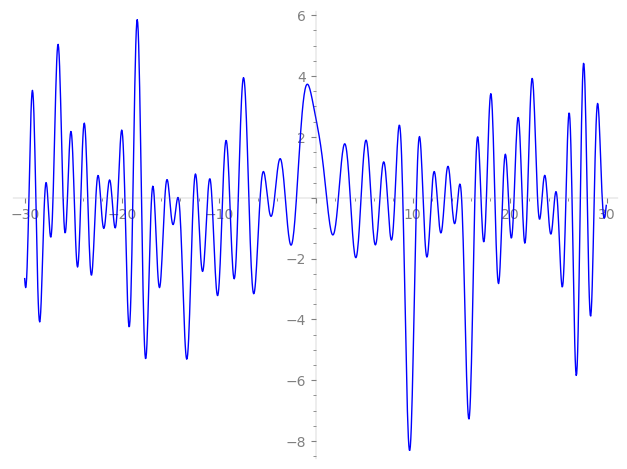| L(s) = 1 | + 2-s + (0.309 + 1.70i)3-s + 4-s + 0.0905i·5-s + (0.309 + 1.70i)6-s + (2.19 + 1.47i)7-s + 8-s + (−2.80 + 1.05i)9-s + 0.0905i·10-s + (1.62 + 0.938i)11-s + (0.309 + 1.70i)12-s + (−1.58 + 0.914i)13-s + (2.19 + 1.47i)14-s + (−0.154 + 0.0280i)15-s + 16-s + (2.76 − 1.59i)17-s + ⋯ |
| L(s) = 1 | + 0.707·2-s + (0.178 + 0.983i)3-s + 0.5·4-s + 0.0404i·5-s + (0.126 + 0.695i)6-s + (0.830 + 0.557i)7-s + 0.353·8-s + (−0.936 + 0.351i)9-s + 0.0286i·10-s + (0.490 + 0.283i)11-s + (0.0894 + 0.491i)12-s + (−0.439 + 0.253i)13-s + (0.587 + 0.394i)14-s + (−0.0398 + 0.00723i)15-s + 0.250·16-s + (0.671 − 0.387i)17-s + ⋯ |
\[\begin{aligned}\Lambda(s)=\mathstrut & 798 ^{s/2} \, \Gamma_{\C}(s) \, L(s)\cr =\mathstrut & (0.131 - 0.991i)\, \overline{\Lambda}(2-s) \end{aligned}\]
\[\begin{aligned}\Lambda(s)=\mathstrut & 798 ^{s/2} \, \Gamma_{\C}(s+1/2) \, L(s)\cr =\mathstrut & (0.131 - 0.991i)\, \overline{\Lambda}(1-s) \end{aligned}\]
Particular Values
| \(L(1)\) |
\(\approx\) |
\(1.98417 + 1.73890i\) |
| \(L(\frac12)\) |
\(\approx\) |
\(1.98417 + 1.73890i\) |
| \(L(\frac{3}{2})\) |
|
not available |
| \(L(1)\) |
|
not available |
\(L(s) = \displaystyle \prod_{p} F_p(p^{-s})^{-1} \)
| $p$ | $F_p(T)$ |
|---|
| bad | 2 | \( 1 - T \) |
| 3 | \( 1 + (-0.309 - 1.70i)T \) |
| 7 | \( 1 + (-2.19 - 1.47i)T \) |
| 19 | \( 1 + (4.22 - 1.05i)T \) |
| good | 5 | \( 1 - 0.0905iT - 5T^{2} \) |
| 11 | \( 1 + (-1.62 - 0.938i)T + (5.5 + 9.52i)T^{2} \) |
| 13 | \( 1 + (1.58 - 0.914i)T + (6.5 - 11.2i)T^{2} \) |
| 17 | \( 1 + (-2.76 + 1.59i)T + (8.5 - 14.7i)T^{2} \) |
| 23 | \( 1 + (-0.0885 - 0.0511i)T + (11.5 + 19.9i)T^{2} \) |
| 29 | \( 1 + (-2.95 - 5.10i)T + (-14.5 + 25.1i)T^{2} \) |
| 31 | \( 1 + (5.97 + 3.45i)T + (15.5 + 26.8i)T^{2} \) |
| 37 | \( 1 + (3.44 - 1.98i)T + (18.5 - 32.0i)T^{2} \) |
| 41 | \( 1 + (-5.54 + 9.61i)T + (-20.5 - 35.5i)T^{2} \) |
| 43 | \( 1 + (2.92 - 5.06i)T + (-21.5 - 37.2i)T^{2} \) |
| 47 | \( 1 + (-3.30 - 1.90i)T + (23.5 + 40.7i)T^{2} \) |
| 53 | \( 1 - 1.79T + 53T^{2} \) |
| 59 | \( 1 + (6.80 + 11.7i)T + (-29.5 + 51.0i)T^{2} \) |
| 61 | \( 1 + (2.93 - 5.08i)T + (-30.5 - 52.8i)T^{2} \) |
| 67 | \( 1 + 10.7iT - 67T^{2} \) |
| 71 | \( 1 + (-5.67 + 9.82i)T + (-35.5 - 61.4i)T^{2} \) |
| 73 | \( 1 + (-6.12 - 10.6i)T + (-36.5 + 63.2i)T^{2} \) |
| 79 | \( 1 - 4.09iT - 79T^{2} \) |
| 83 | \( 1 - 10.2iT - 83T^{2} \) |
| 89 | \( 1 + (-3.81 + 6.60i)T + (-44.5 - 77.0i)T^{2} \) |
| 97 | \( 1 + (14.1 + 8.14i)T + (48.5 + 84.0i)T^{2} \) |
| show more | |
| show less | |
\(L(s) = \displaystyle\prod_p \ \prod_{j=1}^{2} (1 - \alpha_{j,p}\, p^{-s})^{-1}\)
Imaginary part of the first few zeros on the critical line
−10.70369790673167616477757394790, −9.601943601776742914751055164867, −8.865891098417186764649176986511, −7.981762083573169870033686859290, −6.89446052261860360770351373529, −5.72762938031283168676973512026, −4.97014491909437543801799512030, −4.24495809820985551761131643041, −3.13830469826468336797965909910, −1.98496479009681208918056543169,
1.12977093413238645391118857248, 2.33674491453641644515838517786, 3.56168806724585318570523023039, 4.67345872419280317397513713605, 5.69877470187826602091039561937, 6.61867330149323160358692730497, 7.39561010760758024909368766298, 8.164320829080474536362093941895, 8.974895546734561861850586904225, 10.38255315214755710101427010401

